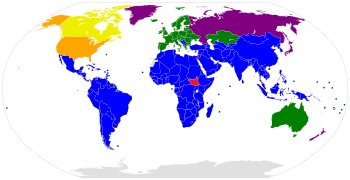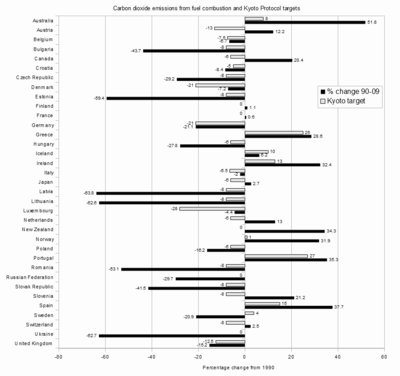Kyoto Protocol
From Wikipedia, the free encyclopedia
Kyoto Protocol
| Kyoto Protocol to the United Nations Framework Convention on Climate Change |

Annex B parties with binding targets in the second period
Annex B parties with binding targets in the first period but not the second
non-Annex B parties without binding targets
Annex B parties with binding targets in the first period but which withdrew from the Protocol
Signatories to the Protocol that have not ratified
Other UN member states and observers that are not party to the Protocol
|
| Signed |
11 December 1997[1] |
| Location |
Kyoto, Japan |
| Effective |
16 February 2005[1] |
| Condition |
Ratification by at least 55 States to the Convention |
| Expiration |
in force
(first commitment period expired 31 December 2012)[2] |
| Signatories |
84[1] |
| Parties |
192[3][4] EU, Cook Islands, Niue and all UN member states, except Andorra, Canada, South Sudan and US |
| Depositary |
Secretary-General of the United Nations |
| Languages |
Arabic, Chinese, English, French, Russian and Spanish |
|
Kyoto Protocol Extension (2012–20)
| Doha Amendment to the Kyoto Protocol |

Acceptance of the Doha Amendment
States that ratified
Kyoto protocol parties that did not ratify
Non-parties to the Kyoto Protocol
|
| Drafted |
8 December 2012 |
| Location |
Doha, Qatar |
| Effective |
not in effect |
| Condition |
ratification by 144 (3/4 of 192 Parties) required |
| Ratifiers |
73[5] |
 Doha Amendment to the Kyoto Protocol at Wikisource Doha Amendment to the Kyoto Protocol at Wikisource |
Kyoto Parties with first period (2008–12) greenhouse gas emissions limitations targets, and the percentage change in their carbon dioxide emissions from fuel combustion between 1990 and 2009. For more detailed country/region information, see
Kyoto Protocol and government action.
Overview map of states committed to greenhouse gas (GHG) limitations in the first Kyoto Protocol period (2008–12):
[6]
Annex I Parties who have agreed to reduce their GHG emissions below their individual base year levels (see definition in this article)
Annex I Parties who have agreed to cap their GHG emissions at their base year levels
Non-Annex I Parties who are not obligated by caps or Annex I Parties with an emissions cap that allows their emissions to expand above their base year levels or countries that have not ratified the Kyoto Protocol
For specific emission reduction commitments of Annex I Parties, see the section of the article on
2012 emission targets and "flexible mechanisms".
The European Union as a whole has in accordance with the Kyoto Protocol committed itself to an 8% reduction. However, many member states (such as Greece, Spain, Ireland and Sweden) have not committed themselves to any reduction while France has committed itself not to expand its emissions (0% reduction).
[7]
The Kyoto Protocol is an international treaty which extends the 1992 United Nations Framework Convention on Climate Change (UNFCCC) that commits State Parties to reduce greenhouse gas emissions, based on the premise that (a) global warming exists and (b) human-made CO2 emissions have caused it. The Kyoto Protocol was adopted in Kyoto, Japan, on 11 December 1997 and entered into force on 16 February 2005. There are currently 192 parties (Canada withdrew effective December 2012)[4] to the Protocol.
The Kyoto Protocol implemented the objective of the UNFCCC to fight global warming by reducing greenhouse gas concentrations in the atmosphere to "a level that would prevent dangerous anthropogenic interference with the climate system" (Art. 2). The Protocol is based on the principle of common but differentiated responsibilities: it puts the obligation to reduce current emissions on developed countries on the basis that they are historically responsible for the current levels of greenhouse gases in the atmosphere.
The Protocol’s first commitment period started in 2008 and ended in 2012. A second commitment period was agreed on in 2012, known as the Doha Amendment to the protocol, in which 37 countries have binding targets: Australia, the European Union (and its 28 member states), Belarus, Iceland, Kazakhstan, Liechtenstein, Norway, Switzerland, and Ukraine. Belarus, Kazakhstan and Ukraine have stated that they may withdraw from the Protocol or not put into legal force the Amendment with second round targets.[8] Japan, New Zealand and Russia have participated in Kyoto's first-round but have not taken on new targets in the second commitment period. Other developed countries without second-round targets are Canada (which withdrew from the Kyoto Protocol in 2012) and the United States (which has not ratified the Protocol). As of July 2016, 66[9] states have accepted the Doha Amendment, while entry into force requires the acceptances of 144 states. Of the 37 countries with binding commitments, 7 have ratified.
Negotiations were held in the framework of the yearly UNFCCC Climate Change Conferences on measures to be taken after the second commitment period ends in 2020. This resulted in the 2015 adoption of the Paris Agreement, which is a separate instrument under the UNFCCC rather than an amendment of the Kyoto protocol.



 Climate Change
Climate Change





_(greyscale).png)


